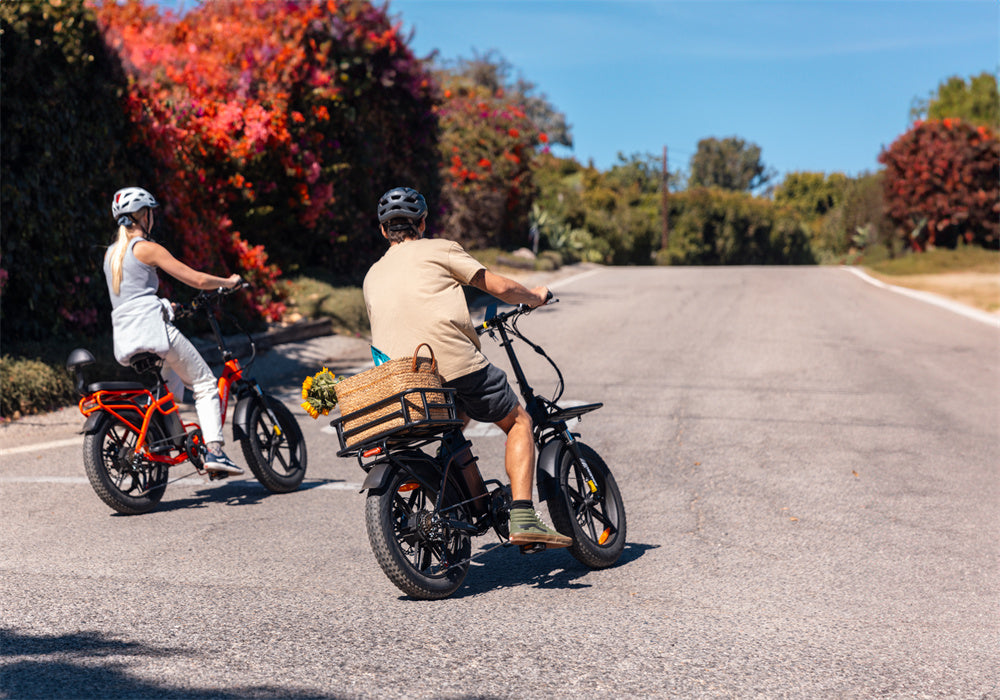500-watt motor is a popular choice in the e-bike world because it neatly balances force and functionality. This motor size is powerful enough to handle a variety of terrains and tasks, from brisk commutes to traversing moderate slopes.
A 500W motor typically generates about 40-60 Newton meters of torque, which translates into noticeable acceleration and the ability to tackle uphill routes more easily than lower-powered options. It provides a robust response without the aggressiveness of higher wattage motors, making it suitable for both novice and experienced riders.

These motors are engineered to optimize power consumption, striking a balance that extends battery life while delivering sufficient power. This makes them particularly suited for longer rides where charging opportunities may be limited.
E-bikes equipped with 500W motors usually feature a variety of riding modes, including eco, normal, and high.
Benefits of Riding a 500W Motor E-bike
Riding a 500W motor e-bike offers several advantages that make it an attractive option for both recreational and practical uses.
Enhanced Speed and Agility: The additional power facilitates maintaining higher speeds with less effort than non-motorized bikes, making it particularly useful in urban environments where stopping and starting frequently is common.
Increased Range: Efficient power use translates into a longer range, typically allowing for 25 to 70 miles on a single charge, depending on the battery size, terrain, and mode used. This makes 500W e-bikes excellent for those who want to use their bike for daily commuting or leisurely tours without the range anxiety associated with electric vehicles.
Adaptability: Whether you're dealing with city streets or country trails, the adaptability of a 500W motor ensures that you can enjoy a consistent riding experience across a variety of landscapes.

Maintenance Tips for 500W E-bikes
Maintaining a 500W motor e-bike is not significantly different from maintaining a regular bike, but the electrical components do require some special consideration.
- Battery Care: To maximize the lifespan of your e-bike's battery, keep it charged between 20% and 80% as often as possible and store it in a cool, dry place. Avoid leaving the battery fully charged or fully depleted for long periods.
- Regular Inspections: Pay attention to the motor and battery connections, ensuring they are secure and free of corrosion. Regularly check the tire pressure, brake pads, and the chain for wear and tear.
- Cleaning and Lubrication: Use a damp cloth to clean the bike and avoid direct water jets that can penetrate the electrical components. Use lubricants that are specifically designed for e-bikes, as they resist washout from the higher forces exerted by the motor.

Top Speeds of 250W, 500W, and 750W Electric Bicycles
Electric bicycles are equipped with motors of varying capacities, each designed to cater to specific riding needs and speed requirements. The peak speed of an e-bike is directly influenced by the power output of its motor, which is typically measured in watts.
250-Watt Motors: Commonly found in entry-level e-bikes, 250-watt motors are ideal for city commuting and light terrain. These motors generally help the bike reach a peak speed of up to 15 mph (24 km/h). This speed is sufficient for navigating urban environments and is compliant with the speed limits set for e-bikes in many European cities.
500-Watt Motors
A step up in terms of power, the 500-watt motors provide a good balance between speed and range, making them popular among both casual riders and commuters. E-bikes with this motor can typically reach speeds up to 20 mph (32 km/h), which aligns with the legal speed limits in the United States for Class 2 and Class 3 electric bikes.
750-Watt Motors
Designed for more demanding riding conditions, including hilly terrains and heavier loads, 750-watt motors can propel an e-bike to about 25 mph (40 km/h). This increased speed capability allows riders to tackle more challenging routes with ease.
1000-Watt Motors and Beyond
For those seeking high performance and speeds, motors rated at 1000 watts or higher are capable of exceeding 28 mph (45 km/h). These are typically used in specialized e-bikes designed for off-road use or for riders looking for a powerful boost. It’s important to note that e-bikes with such high power outputs may not be street legal in all regions and might require specific licensing or restrictions.

Not Always at Top Speed
The speed of an electric bicycle is not solely determined by its motor's wattage; various factors including the rider's weight, terrain, and even the e-bike’s design play crucial roles in affecting the overall speed.
Rider's Weight: The weight of the rider can significantly influence the speed and efficiency of an e-bike. Heavier riders may find that the e-bike accelerates more slowly and reaches lower top speeds compared to lighter riders. For example, a 500-watt motor might propel a rider weighing 150 pounds to the top speed of 20 mph, whereas a rider weighing 200 pounds might achieve speeds only up to 18 mph under similar conditions.
Terrain: The type of terrain also affects the e-bike’s speed. Riding uphill requires more power and usually results in reduced speed. For instance, a 750-watt motor might easily maintain 25 mph on flat terrain, but the speed could drop to 15 mph or lower on steep inclines, depending on the gradient.
E-Bike Design: Factors such as the aerodynamics of the bike, the size and type of tires, and the overall weight of the bike itself also impact speed. Aerodynamic bikes with narrower tires and lighter frames can achieve higher speeds and better efficiency. For example, road e-bikes are generally faster than their mountain e-bike counterparts due to lighter and more streamlined designs.
Battery Capacity and Health: The condition and capacity of the battery also play a role. A fully charged, high-capacity battery will provide more consistent power compared to an older or partially charged battery, thus affecting the potential speed and range.

TESWAY: Speed Awaits at Every Turn
Whether you’re navigating city streets or conquering rugged trails, TESWAY has engineered the perfect ride for every adventurer.
Our commuting bikes redefine urban mobility, allowing you to skip the traffic and transform your daily commute into a vibrant, exhilarating experience.
For the thrill-seekers and nature enthusiasts, our fat tire e-bikes provide unmatched all-terrain capability. Equipped with robust tires that effortlessly grip and glide over sand, snow, and mud, these bikes are crafted to bring you closer to nature’s wonders with unparalleled ease and stability.
At TESWAY, we're passionate about fueling your adventures with the finest in technology and design.
Your journey of speed starts now, with TESWAY. Where will it take you?
FAQs
What is the maximum speed of a 500W motor e-bike?
A 500W motor typically allows an e-bike to reach speeds of up to 20 mph (32 km/h), depending on local regulations.
How far can I go on a 500W e-bike?
The range depends on the battery capacity, rider weight, terrain, and riding mode, but typically, a 500W e-bike can travel 25-50 miles (40-80 km) on a single charge.
Is a license required to ride a 500W motor e-bike?
In most places, no license is required to ride an e-bike with a 500W motor, as it falls under the category of bicycles for regulatory purposes. However, it’s always best to check local laws.







Share:
Thinking of trading your car for an e-bike? More Saving
Expert Tips on Better Waterproofing Your EBike